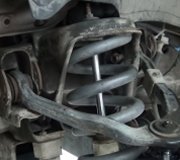What's rubbing, the wheels or the tires? GM already has a lot of trouble with control arm bushings. Worn bushings will allow the top of the wheel to tip in. You also have to look at "scrub radius" which is a product of the suspension geometry. It is not something that can be measured directly but it is carefully designed in to provide proper handling and most importantly, controlled and predictable braking when there's a problem in one of the two brake hydraulic circuits. Scrub radius changes when you install wheels with a deeper offset and when the tires' outside circumference is increased. No experienced suspension and alignment mechanic would ever install wheels and tires that change offset or scrub radius on their own vehicle or for customers.
Original wheels and tires won't rub except after some catastrophic part failure so I have to assume at least one of those dimensions was changed with your aftermarket wheels and tires. Given that they didn't rub at one point, something has caused the wheel to tip or move rearward, or the height of the body has dropped. An inspection at a tire and alignment shop will identify worn ball joints or control arm bushings. They also have books that list the published height specs for every car and truck and where to take those measurements. Only Chrysler's measurement method takes into account tires of different diameters. All other manufacturers specify measuring from some point to the ground. Those numbers are useless with non-standard tires.
If your truck has torsion bars on the front, those can be adjusted up to raise the front end. It is fairly common for them to sag, and they're pretty easy to adjust. The problem is changing ride height changes the geometry of the front suspension and that changes "camber". Camber is the inward or outward tilt of the wheel as viewed from in front. Camber can be adjusted during an alignment but if the ride height of the suspension system isn't correct, the wheel will go through much wilder camber swings as the truck bounces up and down on the road. What that means is camber can look good by the numbers on the alignment computer while the truck is sitting still on the hoist, but there can still be horrendous tire wear related to camber. That's why alignment specialists get so anal over checking and correcting ride height.
Be aware too that many alignment shops won't work on your truck unless you put the original wheels and tires back on first. Lawyers and insurance investigators love to find these kinds of modifications. A shrewd lawyer WILL convince a jury that you were partly to blame for the crash after the other guy ran the red light because you were less able to avoid that crash, ... And he may be right. No mechanic or shop owner wants to be a party to the lawsuit or spend time sitting in a courtroom. We hear about these stories all the time. In fact, I have more than one early '70s muscle car and I make sure everything related to the brakes, suspension, and ride height is exactly as the manufacturer designed it. It paid off when a girl turned in front of me a few years ago. I pushed the right rear tire on her Taurus half way across the trunk and laid it flat on the ground. Didn't even break a head light on my Challenger. No lawyers got involved because they knew my car was well maintained and exactly as it was designed, so there was no way to shift any of the blame onto me.
SPONSORED LINKS
Saturday, October 27th, 2012 AT 8:45 PM



